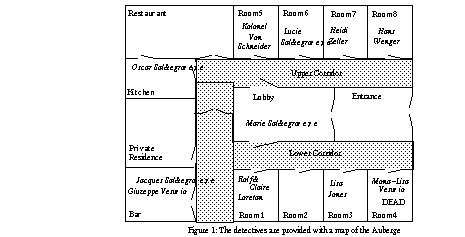




Grounding in Multi-modal Task-Oriented Collaboration
3 Experimental setting
The subjects are engaged in a collaborative diagnosis task: they have to solve a murder mystery together. They are located in different rooms and communicate through networked computers, using two pieces of software, a MOO system and a Whiteboard.
- The task. Two subjects play a mystery solving game: Mona-Lisa Vesuvio has been killed and they have to find the killer.The subjects play the parts of the detectives Sherlock and Hercule. They walk in a text-based virtual world (a MOO environment) where they meet suspects, ask questions about relations with the victim, regarding what they have done before the murder, and so forth. Suspects are programmed robots. The two detectives explore rooms and find various objects which help them to find the murderer. More precisely, they are told that they have to find the single suspect who (1) as a motive to kill, (2) had access to the murder weapon and (3) had the opportunity to kill the victim when she was alone.
- The MOO environment.[1] This is a standard MOO called TECFAMOO, developed in our research team.[2] The subjects move in different rooms (see figure 1), where they find suspects and objects. They talk to each other via two commands: "say..." to communicate with anybody in the same room, and "page <Player>..." to communicate with this player wherever he is. We have also augmented the standard MOO commands with others implemented specially for these experiments. This area of TECFAMOO is protected against the entry of other visitors. All actions and communications are recorded. The subjects carry a notebook which automatically records the answer to all the questions that they ask, organizing it by suspect and subject, to allow easier retrieval. In these experiments the subjects used a MOO client called Mudweller which runs on Macintosh. This client displays about 60 lines of text without scrolling back (any interaction uses several lines) and, provides a 3 line text entry pane.

- The Whiteboard. The subjects were invited to draw any representation that they felt would be useful to solve the problem. Drawings were displayed on the screens of both subjects, using a shared whiteboard (a component of the BeingThere 2.0 groupware system). This program only supports elementary drawing: boxes, lines (with or without arrows), and text frames of different colours and thicknesses. It does not include free drawing and does not enable users to edit displayed text. Users can move, remove, resize or change colour of objects, regardless of who created them. They cannot see each other's cursor. They can copy and paste in the whiteboard and also from the MOO (e.g. pasting the list of suspects). Both users see the same fixed area, there is no scrolling of the whiteboard window.The MOO and the whiteboard are side by side, splitting the Macintosh screen into two 14 X 19 cm areas. The two detectives are provided with a map of their virtual environment (see Figure 1), so that the drawn schema focus on the inquiry itself instead of on a (trivial) spatial representation of their environment. We recorded the interaction on the whiteboard (1 image per second)
- Subjects were familiarized with the MOO and the whiteboard through a training task, in which they explored a MOO area of 7 rooms, and draw a map of these rooms and their contents on the whiteboard. The subjects received 30 Swiss Francs to do both tasks.
[1] MOOs [Curtis93] are virtual "environments" on the network where people can meet and communicate. Technically speaking, a MOO is a network-accessible, multi-user, programmable, interactive system. When a user connects to a MOO he connects as a character with the help of a specialized telnet-based client program.The client's primary task is to send and receive I/O between the server and the user. The MOO server exists on one machine on the network, while the client is typically run by the users on their own machines. Having connected to a character, participants then give on-line commands that are parsed and interpreted by the MOO server as appropriate. Such commands may cause changes in the "virtual reality", such as the location of the user. In the MOO architecture, everything is represented by objects. Each person, each room, each thing is considered as an object that can be looked at, examined and manipulated. The MOO keeps a database of objects in memory and this means that once created objects are still available in future sessions. A MOO world can be extended both by "building" and by programming. "Building" means creation and customization of new objects starting with some prototypical object. The internal object-oriented programming language is quite powerful and has been used to create a large set of objects for professional and academic use.
[2] TecfaMOO has been used in our research team for various purposes including distance collaboration and learning. It is accessible via telnet or a MOO client at: tecfamoo.unige.ch (port 7777). An information page is at http://tecfa.unige.ch/tecfamoo.unige.ch
Grounding in Multi-modal Task-Oriented Collaboration - 3 SEP 1996
Generated with Harlequin WebMaker






